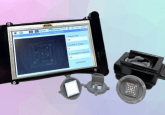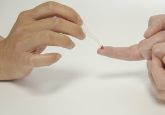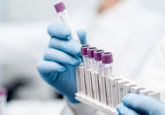Bioengineers develop wearable sensor that has the capacity to measure glucose in sweat

Bioengineers from the University of Texas at Dallas (Richardson, TX, USA) have developed a wearable, flexible electrochemical biosensor that has displayed the capacity to detect and quantify glucose levels in 1 μL of sweat that could be utilized by diabetes patients at home, as a less invasive glucose monitor.
The study, recently published in Sensors and Actuators B: Chemical, demonstrated the capability of the device to reliably detect and quantify an individual’s glucose level via perspiration on the skin. The novel device utilizes gold/zinc oxide thin films within porous polyamide substrates for low-volume ultrasensitive impedance based detection of glucose and cortisol using non-faradaic electron-ionic charge transfer.
“Fitness trackers that monitor heart rate and step count are very popular, but wearable, non-invasive biosensors would be extremely beneficial for managing diseases,” commented Shalini Prasad.
“In our sensor mechanism, we use the same chemistry and enzymatic reaction that are incorporated into blood glucose testing strips. But in our design, we had to account for the low volume of ambient sweat that would be present in areas such as under a watch or wrist device, or under a patch that lies next to the skin.”
The team designed the sensor to control for variable volumes of sweat production and the variety of compounds present that could interfere with glucose measurement, such as cortisol and lactic acid. They investigated the accuracy of the device utilizing synthetic and human sweat collected from donors. A reliable limit of detection of 0.1 mg/dL in human sweat was observed.
“Our modifications allow this material to entrap glucose oxidase molecules, which effectively amplifies the signal,” Prasad elaborated. “We did it this way because we are thinking about possible commercialization – to make these we need a fabrication process that is not complex.”
“At this point, we are thinking of this sensor as something you use for a day and toss out, and we believe it could easily be incorporated into existing consumer electronics platforms,” Prasad concluded. “We’re very excited about the potential for licensing this technology.”
Sources: Munje RD, Muthukumar S, Prasad S. Lancet-free and label-free diagnostics of glucose in sweat using Zinc Oxide based flexible bioelectronics. Sens. Actuator B-Chem doi:10.1016/j.snb.2016.07.088 (Epub ahead of print) (2016); www.utdallas.edu/news/2016/10/13-32235_Bioengineers-Create-Sensor-That-Measures-Perspirat_story-sidebar.html?WT.mc_id=NewsHomePageCenterColumn






